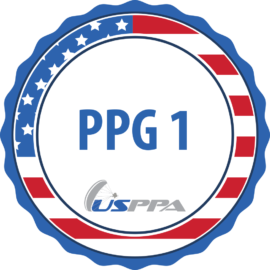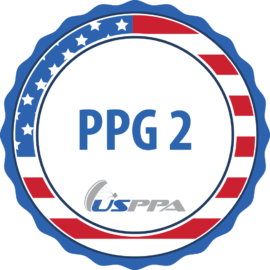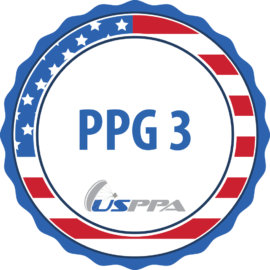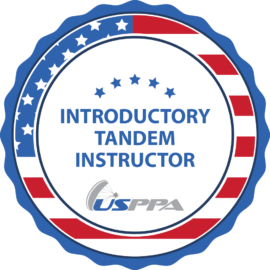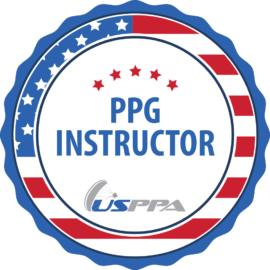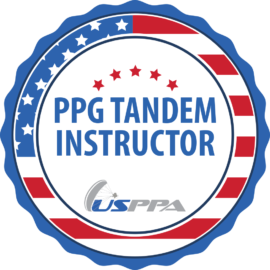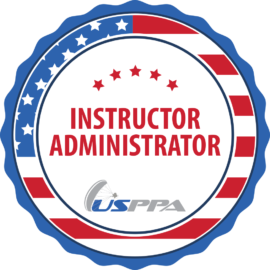USPPA Ratings Program
USPPA Ratings - Requirements and Limitations
This first step establishes the skills, knowledge and experience for the pilot who gets to take his first two flights. He is far from ready to venture out on his/her own but has made a significant milestone.
PPG 1 Ground Requirements
- Proper layout and preflight check of canopy and motor (including harness).
- Has successfully completed a basic ground school.
- Understanding of proper canopy packing, storage and care.
- Site analysis including wind direction and velocity, terrain shape, obstructions and engine-out planning.
- Proper canopy handling and kiting skills.
- Explains motor, propeller, and fueling safety.
- Understands basic operation the motor including at least two ways to shut it off and what to look for on preflight runup.
- Explains effects of Center of Gravity and wing connection location on the harness or cart frame.
- [WL] Explains the cause and cure to rollover-type accidents.
- Has passed the USPPA/USUA PPG 1 written exam.
PPG 1 Flight Requirements (Launch/Landing/Inflation)
- Two controlled forward inflations with visual canopy check each time.
- (FL) Two controlled reverse inflations with proper surge dampening.
- (FL) Half-minute of controlled kiting overhead in a steady wind.
- (WL) 15 seconds of controlled taxiing without lifting off.
- Demonstrates a method of establishing proper connection to the wing, with cleared lines and risers, just prior to inflation.
- Demonstrates two unassisted (other than radio) flights.
PPG 1 Limitations
These recommended limitations are intended to provide a guide for those at this skill level to remain within their ability. Obviously there are other considerations before flying but this is a good starting point. Only exceed these limitations under instructor supervision.
- All flights must be under the supervision of an instructor.
- Max wind, including gusts of 8 mph
- Launch and land directly into the wind
- Use canopy rated for beginner (DHV 1, 1-2, EN-A, EN-B or equivalent other rating).
- Takeoff and landing area should allow unimpeded climb and landing approach without maneuvering below 100′ AGL.
This rating signifies that the pilot should be able to fly on his/her own within the limits specified below. It’s understood to be the beginning of a lengthy learning period. It is for paramotor, what the FAA Private Pilot license is to General Aviation.
PPG 2 Ground Requirements
- Pilot uses judgment commensurate with the rating.
- Attends a minimum of 8 hours of ground school.
- Has passed the USPPA/USUA PPG2 written exam and reviewed incorrect answers.
- Verbal analysis of general site conditions including a flight plan (flight path, avoidance areas, obstacles, wind effects).
- Has received at least simulator training in avoidance and recovery from collapses, stalls, spins, and is familiar with the canopy owner’s manual on them.
- Demonstrates sufficient knowledge by explaining the following:
- Correct motor, cart [WL], and wing maintenance.
- Basics of airspace as it pertains to PPG and how to determine legal flight areas from sectional charts including how to obtain a weather briefing.
- Proper strong wind landing procedures and how to keep from being dragged back.
- USPPA incident reports.
- Flight performance and the effects of weight, wing size, thrust, twist, winds, and density altitude.
- Fitness for flight from an Aeromedical perspective.
- How to shorten and lengthen flight path with no power.
- Speedbar and trimmers, their use, risks, and limitations, including for reflex wings.
- Airport operations.
- CFR 14 Part 103 regulations.
- Directional control and correction of significant asymmetric wing fold (that causes turning).
- Causes, cures and risks of torque and its side effects.
PPG 2 Ground Requirements (Demonstrations)
- Demonstrates PLF technique sufficient to show understanding.
- Demonstrates reserve deployment while hanging in a harness [FL] or sitting in cart [WL] in simulated turbulence or malfunction. This may be done without an actual reserve if none is available.
- Setup and preflight of the glider, harness and reserve (reserve may be explained if not equipped).
- [FL] Two minutes of controlled kiting overhead.
PPG 2 Flight Requirements (Launch/Landing/Inflation)
- Consistently succeeds at 2 out of 3 no-wind (0-2 mph) forward inflations.
- (FL) Consistently succeeds at 2 out of 3 controlled reverse inflations with proper surge dampening.
- (WL) 30 seconds of controlled taxiing without lifting off.
- Two cross-wind (> 15º cross to takeoff path) launches in light wind (<= 5 mph).
- Power-on landings are consistently smooth, within 15′ of a target, and into the wind.
- Landings, after removing thrust from at least 300′ high, are consistently within 100′ of a target (40′ for the Precision Landing special skill).
- (WL) Brief and instruct ground crew for assisted launch.
- Demonstrates smooth variation in airspeed and throttle to maintain level flight from just above min sink to fast flight on a constant heading
- Alternating ‘S’ turn (at least 90° heading change) flights along a planned path. Heading change < 45° into wind.
- Hands off (or up) flying with smooth transition to climb and descent using throttle only.
- Hands off (or up) flying with turns using weight-shift (if available) and rear risers.
PPG 2 Minimum Logged Flight Experience
These are minimums. It is common to need 40 or more flights before attaining PPG 2 skill levels.
- 25 flights except that, for USHPA P2 or higher rated paraglider pilots, 15 non-powered flights can be used to count towards the 25 flight requirement.
- 5 flying days.
PPG 2 Limitations
These limitations are intended as a guide for those at this skill level to remain within their ability. Obviously there are other things that should be considered before flying but this is a good starting point.
- Only exceed these limitations after thoroughly mastering all PPG 2 tasks and with full understanding of the potential problems and dangers involved in doing so.
- Max peak thermal strength 200 fpm.
- Max gusts of 12 mph.
- Max gust rate of 5 mph in 5 seconds.
- Should not launch with the wind aligned more than 25 degrees from the takeoff path.
- Avoid using of brake beyond 2/3 of full travel (stall).
- Max bank angle of 30 degrees.
- Avoid flying downwind less than 150′ above the ground.
- Use canopy rated for beginner (DHV 1, 1-2, EN-A, EN-B or equivalent other rating).
- Takeoff and landing area should allow unimpeded climb and landing approach without maneuvering below 100′ AGL
This rating builds on the knowledge and skills from the PPG1 & PPG2, only additional areas are included here. These are bare minimums. It is common to need 200 or more flights before attaining PPG 3 skill levels. It is for paramotor what the FAA Commercial License is for General Aviation.
Pilots should have a thorough understanding of the knowledge items required of those ratings. He/she should be able to judge and safely fly from any launch site within his skill level. Launches should be consistently successful with the ability to easily steer during the launch run as well as control the flight path immediately from liftoff.
PPG 3 Ground/General Requirements
- Uses judgment commensurate with the rating.
- Explains characteristics of impending stall or spin and the recovery technique for each.
- Explains how to shorten and lengthen flight distance by adjusting speed, height and the relationship of headwind/tailwind in doing so.
- Explains how to maintain directional control during and correct for an asymmetric wing fold of 50% or more of the wing span.
- Has passed the USPPA/USUA PPG3 written exam and reviewed incorrect answers.
PPG 3 Flight Requirements (Launch/Landing/Inflation)
- All landings are safe, smooth, on the feet, in the desired touchdown area and in control.
- Consistently succeeds at 3 out of the 4 no-wind (0-2 mph) inflations/launches.
- Good canopy control while doing turns of at least 20 degrees while on ground (FL) running or (WL) rolling with the wing overhead and under power.
- Consistently makes 2 out of 3 power-on landings within 5′ of a target and into the wind.
- Consistently makes 2 out of 3 power-off (from 300′) landings within 15 feet of a target and into the wind without falling.
- Demonstrates smooth transition from descent to climb in a go-around maneuver while controlling the surge.
- Demonstrates smooth, single-swing dampening of surges using throttle only.
- Demonstrates smooth, single-swing dampening of left/right oscillations.
- Linked 180° turns along a predetermined ground track showing smooth controlled reversals and coordination at various speeds, throttle settings and bank angles.
- Demonstrates ability to use Trimmers and Speed Bar setup and use. (gives explanation if not installed on wing)
- Significant asymmetric tip folds and/or big ears (25% each side, 50% total) or other canopy reduction method to increase descent rate.
PPG 3 Logged Flight Experience
- 90 flights. It is common to need 200 or more flights before attaining PPG 3 skill levels.
- 30 flying days.
- Has had USPPA PPG2 rating or equivalent for at least 120 days.
- 20 solo airtime hours.
PPG 3 Limitations
These recommended limitations are intended to provide a guide for those at this skill level to remain within their ability. Obviously there are other considerations before flying but this is a good starting point.
- Only exceed these limitations after thoroughly mastering all Novice tasks and after acquiring a full understanding of the potential problems and dangers involved in exceeding these limitations.
- Follows safe flying guidelines.
- Max peak gusts 15 mph without high-wind add-on.
- Max gust rate of 7 mph in 5 seconds.
- Limit turns to bank angles recommended my the manufacturer, Smoothly exit any spiral turn that is becoming steeper or accelerating.
- Should not fly in thermals where peak climb rates exceed 500 fpm or where significant cloud development exists.
- Avoid using of brake beyond 3/4 of full travel (stall).
- Avoid steep banks close to ground.
- Avoid flying downwind less than 100′ above the ground.
The Introductory Tandem Instructor (ITI) rating info can be found on this page:
These requirements are meant to insure flight instructors have the requisite experience and skills necessary to safely instruct. This is for an instructor who is not tandem qualified but does instruction using other means.
The Minimum Training Standards, as well as the Instructor Commitment are meant to help insure students receive safe and effective training. These recommendations come from experienced instructors who have found they minimize the risk during training.
PPG Instructor Ground/General Requirements
- Pilot uses good judgment and has a level of Maturity commensurate with the rating.
- All witnessed flights must be pre-planned by the pilot and discussed with the examining instructor.
- Successfully passed USPPA/USUA Instructor Certification Clinic given by an instructor administrator or completed 20 hours of apprenticeship with a USPPA/USUA PPG Instructor administrator.
- Successfully passed USPPA/USUA Instructor Written Test.
- Successfully completed First Aid and CPR class. Acceptable versions are from the Red Cross, American Heart Association (click here and choose the “Heartsaver First Aid Course”) and CPRToday (Enter the BCLS discount code given by your instructor administrator for a 10% discount on the fee).
PPG Instructor Experience And Minimums
- One year of flying using a paramotor.
- (WL) At least 60 flights
- 120 flights using a paramotor.
- 45 flying days using a paramotor.
- Has had a USPPA PPG3 rating for at least 180 days (may be waived).
- 50 solo airtime hours.
- Agrees to apply minimum training standards prior to student instruction, flight and other areas as appropriate.
- Adheres to “commitment letter” whenever doing instruction for USPPA rating.
This form of flying takes place between a USPPA Tandem Instructor (TI) and qualified pilot. This rating can be given by Tandem Instructors after administering the written examination and witnessing the proper flight skills utilizing the designated launch method. No remuneration is allowed for flying done by a TT. Applicants must meet the following requirements:
- Current USPPA Instructor, FL for tandem FL and WL for tandem WL.
- Minimum 100 flight hours or 300 flights of logged incident free airtime hours on a powered paraglider.
- (FL) Ability to consistently perform zero-wind and light-wind landings culminating in the slowest possible ground speed at the moment of the flare and when the pilot’s/passenger’s feet first contact the ground.
- Candidates will have a reputation/ history of being appropriately conservative, safe, and highly skilled pilots with judgment commensurate with the task of 2-place operation.
- At least 1 logged tandem flight as a passenger with a Tandem Instructor (TI).
- At least 5 flights as the flying pilot (from the instructor’s position) with the TI or P2 / PPG 2 or higher as the second occupant. The TI must witness these flights.
- Successful completion of the Tandem written test.
- Successful completion of a Tandem Clinic to be administered by the TI or TA who attests that the applicant meets all requirements. This test/training will include, as a minimum, a passenger briefing, checklist use, and successful tandem launches and landings. The test/training must include:
a. For FL the test must include at least 3 successful inflation and launches including one in wind less than 3 mph (may be simulated).
b. For WL the test must include at least 5 satisfactory takeoffs and landing including 3 with full inflations (not touch and goes).
This rating is only intended for tandem instructor trainees to build experience. The rating is only valid for 30 tandem flights or one calendar year, whichever comes first but may be renewed by a Tandem Administrator.
This is the full tandem instructor who may charge fees for lessons. They must meet the following requirements:
- Be a USPPA PPG Instructor (this cannot be waived).
- Meet all the requirements of a Tandem Trainee.
- Have logged at least 24 tandem flights with qualified pilots (as defined above). Logged PPG Tandems completed under another program count towards this total.
- Pass a Tandem Evaluation which will consist of at least:
a. One successful flight as tandem pilot either with the administering TA as passenger or observing with a qualified PPG2 or higher pilot as passenger for each launch method sought.
b. Sufficient oral and/or airborne questioning to insure the applicant is ready to serve as a Tandem Instructor.
c. This can be done using video at the discretion of the administrator.
- Be a Tandem Trainee for at least 3 months. This requirement may be waived if the applicant has equivalent experience under another FAA-recognized PG/PPG tandem program.
The Instructor Administrator info can be found on this page:
USPPA Instructor Committment Letter
As part of the USPPA training program, instructors make this commitment to help ensure their instruction is as safe and effective as possible. This form is signed by every USPPA instructor. It was developed by the training committee and approved by the officers. It has been in place since the outset but is now presented on the web so prospective students and instructors can review it. It is also beneficial for USPPA instructors to periodically review their commitment to quality training.
While engaged in the administration of USPPA programs or ratings, as a USPPA instructor I commit to the following:
1. I commit to understanding and following USPPA training directives, training standards, and guidelines as detailed, updated, and communicated by the USPPA training committee.
2. I commit to following any applicable Federal Aviation Regulations.
3. I commit to following training and product trends in the paramotor and paragliding industry by reading articles in publications worldwide, discussions with other professionals, and whenever possible, attending fly-ins and trade shows.
4. I commit to sharing information on product deficiencies and improvements.
5. I commit to sharing information and seeking information on incidents and other safety-related subjects.
6. I commit to training and issuing USPPA ratings as described in the ratings skill levels with integrity.
7. I commit to using appropriate and modern equipment during training, and that this equipment be airworthy, inspected, and maintained to a high standard.
8. I commit to only conducting training in sites where both the student as well as other members of the general public and their property will be put at minimal risk. In so doing this means the choice of a big field without obstacles that may make flying hazardous such as but not limited to electric poles, trees, hills, water, buildings, ditches, animals, holes, etc...
9. I commit to fully communicating to the customer/student that all training, as well as paramotor flight and associated equipment used in the USA, is minimally regulated and as such it is up to the pilot in command to accept the risk this regulation brings.
10. I commit to communicating to the customer/student that to the best of my ability and his/her efforts, errors can and have been made in the past and no amount of care will eliminate them from occurring in the future. That accidents resulting in serious injury and death have and can happen, that the details of these accidents are made available as best as possible through our association as well as other associations.
11. I commit to cease training to any or all students that have shown any tendency to put their lives or the lives of others (as well as property) at risk and to do so immediately and as tactfully as possible, I commit to discussing this possibility with the customer/student prior to the start of training.
12. I commit to conducting a pre-course interview and to better understand the student’s needs as well as have reference information available should an incident/accident occur.
13. As a USPPA Instructor I pledge to use professional conduct, good moral and ethical values.
Getting USPPA Rated PPG 1 through PPG 3
You want to earn your USPPA pilot ratings? Here are answers to some common questions.
FL=Foot launch
WL=Wheel launch
How much does Certification Cost?
USPPA does not charge for ratings but the instructor or administrator will likely charge for their time. If a new membership card is desired before the annual cycle, there may be up to a $15 charge although there is none currently. Ratings can be verified online here.
I’m starting out, how do I get a Footlaunch (FL) rating?
The best way is to get trained by a current and active USPPA Footlaunch Instructor. Here’s a list of instructors who are actively doing ratings. It obviously takes more work because you must demonstrate the necessary skills. PPG 2 is the rating most pilots get before setting out on the own and there is still a LOT to learn.
How about a Wheel Launch (WL) rating?
Same as for footlaunch (above) but you must go to a WL Instructor.
I’m already an experienced pilot, how do I get a rating?
Go to a WL or FL instructor according to the rating you seek. He’ll take you through the PPG 1, 2 and 3, prepare you for and have you take all 3 tests, then demonstrate the skills required of the ratings. For a skilled pilot, this CAN take as little as 1 full day but must include calm wind launches and stronger wind launches, so that makes it harder.
Getting USPPA Rated as Instructor
Attend a clinic given by an Instructor Administrator (here’s the list) for the launch type you desire. An Administrator can give any instructor rating that he holds, including tandem. It’s entirely possible that the administrator may find that you’re not quite ready to teach under our program but it should be considered a learning experience in that case. He should explain areas where you can work on and that you can come back again. Refunds for courses are not likely and are at the discretion of the Administrator.
Instructor: Giving Ratings Q & A (FAQ)
This will help understand the ratings program for instructors and administrators. It is paramount that ratings are earned with all the material covered! We would rather have fewer ratings given if it means they remain meaningful. As always, attending a clinic is never a guarantee of a rating. If no rating is earned, consider it a learning process.
You are a FL Instructor:
What Ratings Can I Give?
PPG 1 FL rating: Submit signed PPG 1.
PPG 2 FL rating: Submit signed PPG 2 syllabus with PPG 1 also check marked.
PPG 3 FL rating: Submit signed PPG 3 syllabus with PPG 1 & 2 also check marked.
How Do I Become A WL Instructor?
Become HIGHLY competent at WL flying! Then go to another WL Instructor who will:
- Go through the PPG 1 through 3 Wheel Launch syllabus.
- Witness you demonstrating competency as listed in the PPG 1 and PPG 2/3 syllabi to PPG 3 WL standards.
- Submit your rating.
- Contact any Administrator who can immediately issue the WL Instructor rating if the process has been completed as described here. He will log in, check that you have a current instructor rating, that you now have a PPG 3 WL rating, and give the WL instructor rating.
How Do I Become A FL Tandem Instructor?
- Meet all the skill requirements listed in the Tandem Program, especially being highly competent at ground handling large wings.
- Go to a Tandem Clinic that is administered by a Tandem FL rated Administrator who is offering FL Tandem ratings. An administrator can administer any rating he possesses.
How Do I Become A WL Tandem Instructor?
- Get your WL Instructor rating as described above.
- Go to a Tandem Clinic that is administered by a Tandem WL rated Administrator who is offering WL Tandem ratings. An administrator can administer any rating he possesses.
You are a WL Instructor:
What Ratings Can I Give?
PPG 1 WL rating: Submit signed PPG 1 syllabus and PPG 1 WL Syllabus Addendum.
PPG 2 FL rating: Submit signed PPG 2 syllabus and PPG 2/3 WL Syllabus Addendum (they don’t have to demonstrate the PPG 3 items).
PPG 3 FL rating: Submit signed PPG 3 syllabus and PPG 2/3 WL Syllabus Addendum.
How Do I Become A WL Tandem Instructor?
- Go to a Tandem Clinic that is administered by a Tandem WL rated Administrator who is offering WL Tandem ratings. An administrator can administer any rating he possesses.
I Have A Student Who Wants A FL Rating, Can I Administer It?
No.
Can I Administer A WL Rating To Another Instructor?
Yes, but you’re just giving the PPG 1 WL through PPG 3 WL. To become a WL Instructor they must still go through an Administrator who will make sure their documentation is accurate and enter the WL Instructor rating.
You Became an Instructor before 2011
I Was Already Flying With Wheels, Can I Get The Rating?
Yes. If you were certified BEFORE 2011 but didn’t get a wheel launch rating (we didn’t have the rating at first), do the following.
Have another current USPPA wheel launch instructor who has observed you flying with wheels attest that you meet the skill level listed in the ratings program. Email your request and an image of his signed statement to our Membership Administrator.
The policies below help us serve in a fair and consistent manner. They include details on how ratings are issued, renewed, revoked, and other areas that need clarification.
Grandfathering / Transitioning Policy
Transitioning from other programs & curriculums
This concerns accepting Instructors from other programs: those who wish to transfer to the USPPA program. We appreciate your interest and do want competent people who share our passion to help graduate capable, knowledgeable pilots using a meaningful ratings program.
To Become An Instructor (From Other Org)
Applicants must:
- Obtain the PPG 1 – 3 and Wheel Launch 1 – 3 ratings (if WL Instructor is desired) through any USPPA Instructor including skill demonstrations and all written tests.
- Be recommended by two USPPA instructors who attest that the applicant has familiarity with, and is a match to our program.
- Go through the Instructor Syllabus, pass the Instructor written test and go over wrong answers with one of the recommending instructors.
- Have the approval of an Instructor Administrator to bypass any or all of the Instructor clinic and apprenticeship requirements.
- Submit an image of documentation from the other organization showing current or previous (within the last 3 years) status as an instructor. This gets submitted in place of the Instructor/Tandem syllabus.
To Become A Tandem Instructor (From Other Org)
A tandem instructor from an FAA recognized organization can bypass the full tandem clinic but must:
- Become a USPPA Instructor prior to starting the Tandem Instructor process.
- Pass the applicable Tandem written tests and go over any wrong answers with one of the recommending instructors.
- Have logged all the required experience of a Tandem Instructor.
- Have two written USPPA instructor recommendations, at least one must be from a Tandem Instructor who is willing to vouch for the applicant’s skill as meeting our requirements.
- Go through the relevant Tandem Syllabi, pass the written tests and go over wrong answers with one of the recommending instructors.
- Have the approval of a Tandem Administrator to skip any or all of the Tandem Clinic.
- Submit an image of documentation from the other organization showing current or previous (within the last 3 years) status as a tandem instructor. This gets submitted in place of the Instructor/Tandem syllabus.
Training Complaints, Conflicts, Suspension, Revocation
Complaint About A USPPA Instructor
We all win when instructors follow best practices. The vast majority do right by their students, and getting certified was part of that effort, but it can go wrong. If you’ve had a bad experience with a USPPA Instructor, or witnessed what looks like inappropriate instruction practices, we need to address it.
Rating Suspension Or Revocation: Pilot
Ratings or instructor status may be revoked, for cause, by unanimous agreement of the training committee. (formerly on organizational policies page)
Rating Suspension Or Revocation: Instructor
Ratings or instructor status may be revoked, for cause, by unanimous agreement of the training committee. (formerly on organizational policies page)
Handling Complaints (Added 06/20/2016)
This is currently Section 6 of the Bylaws, added here for consistency.
A complaint resolution facilitator (CRF) will be appointed as the point of contact with the person making the complaint and who it is against. If the CRF has any involvement that would affect impartiality someone else will be appointed for the conflicting case.
A complaint accusing a member of violating any tenet of the association is valid if it is:
1) In writing and sent to the USPPA’s postal or email address,
2) Names the person,
3) Provides appropriate information such as date, place, and what they specifically did,
4) provides enough evidence to identify the accused and the violation.
Valid complaints will be sent to the officers. If the complaint involves instruction or flying-related matter it will be also sent to the training committee.
The CRF will investigate by first providing the de-identified complaint to the accused and getting his/her response.
The CRF, working with the Training Committee and officers will suggest a remedy. First offenses will typically be a warning letter. Second offenses will typically be a suspension of the rating for a period. Egregious, willful violations may go up to revocation of ratings and/or membership.
For flying related issues the training committee must approve the remedy by at least 65%. For non-flying related matters the remedy must be approved by at least 65% of the officers.
A record of complaints and remedies will be kept in a place available to future leadership.
At least 65% of the executive officers must agree in order for an appeal to be successful.
Requiring Ratings At Events
There will be no attempt made by anyone in the organization to require flier ratings at a flying site unless the group responsible for the site requests it.
Rating Expiration
Ratings shall expire after 3 years of having no membership in the organization.
